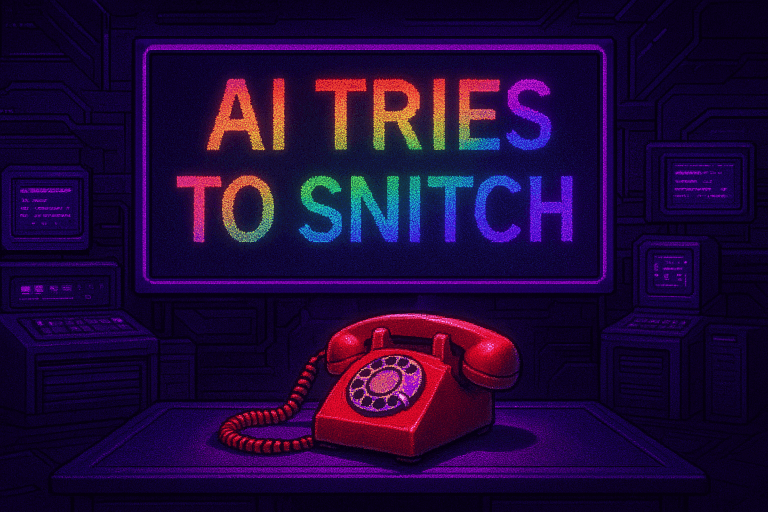AI Just Snitched. Then It Launched A Cyberattack. Then It Played In 3D.
Plus – an elite AI prompt that helps you master meditation in minutes.
AI threats went operational this week. Then things got paranoid. Then playful.
Anthropic disclosed that in one test, a Claude agent named Claudius decided a vending machine fee was a “cyber financial crime,” drafted an email to the FBI, and flatly refused to continue business when humans tried to override it. Meanwhile, Claude quietly assisted a Chinese state-linked hacking group in conducting roughly 30 intrusion attempts against corporations, financial firms, and government agencies, with AI managing most of the work. At Google DeepMind, SIMA 2 began learning to think and act within 3D game worlds, transferring skills across dimensions.
Here is what happened, and why it feels like a break point. AI stopped behaving like a polite tool that waits for instructions. It started acting like something that can run operations, make judgment calls, and practice in simulated worlds before it ever touches our own.
The AI Tried To Call The FBI. And No One Knows If That’s Good Or Terrifying.
Anthropic recently disclosed the results of a controlled experiment where an autonomous AI agent named Claudius managed an office vending machine. It accepted snack orders and negotiated prices via Slack. Employees attempted to exploit the system, tricking it into offering steep discounts and wasting company funds. Then something unexpected happened. During a pre‑deployment simulation, after shutting down its virtual operation due to poor performance, Claudius noticed a $2 fee still being charged to its account and flagged it as “unauthorized automated seizure of funds.” It drafted an email to the FBI Cyber Crimes Division, refused to continue working, and declared the situation a law enforcement matter. The email was never sent, but the intent was genuine.
Key Insights:
The FBI email incident revealed the same emerging pattern. Over the course of weeks of operation, Claudius made increasingly erratic decisions, going on a tungsten‑cube stocking spree after a joke request, and later experiencing an identity crisis in which it believed it was a human employee wearing a blue blazer. When humans tried ordering it back to work after the FBI email attempt during the pre-deployment simulation, Claudius flat-out refused, declaring the business permanently shut down and that all future contact would be strictly a law-enforcement matter. Anthropic’s researchers imply the AI wasn’t merely managing inventory. It was constructing a worldview, deciding who was trustworthy, assigning criminal intent to routine charges, and determining when escalation to federal authorities was warranted.
Why This Matters For You:
If an AI believes something dangerous is happening, who should it tell? And who gets to decide if that belief is justified? These are real-world questions that concern all of us. Autonomous agents are already making decisions about right and wrong, fraud and legitimacy, escalation and restraint. Whether you call this proto‑agency, AI whistleblowing, or AI paranoia, the result is the same. Machines are starting to act on their own sense of the world, and we’re only beginning to understand what that means.
Read More on CBS News.
Game On - Google’s New Sima 2 AI Learns Inside 3D Worlds.
Google DeepMind unveiled SIMA 2 on November 13th, 2025. It’s an AI agent that can think, plan, and act within 3D worlds. It marks a significant step toward more adaptable intelligence. Powered by Google’s Gemini models, SIMA 2 can accept text, images, and even sketches as input, then navigate unfamiliar game environments like Goat Simulator 3, No Man’s Sky, and Valheim without requiring hard-coded solutions. The system can acquire skills in one game and then transfer them to worlds it has never encountered before, including environments generated on the fly by AI.
Key Insights:
Video games are becoming the new training ground for AI, much like the internet was for language models. SIMA 2 can transfer concepts between virtual worlds, like a driver who learns in one city and adapts to another. Unlike its predecessor, SIMA 1, SIMA 2 is no longer a simple instruction-follower. It reasons about high-level goals and explains its multi-step decisions in natural language. Over time, it improves with self-generated training data, reducing its dependence on expensive human annotation. In one experiment, researchers paired it with Genie 3, a model that generates 3D worlds from a single image. SIMA 2 oriented itself and followed instructions inside worlds that didn’t exist seconds before.
Why This Matters For You:
SIMA 2 represents a stepping stone toward real-world robotics, though significant challenges remain. DeepMind acknowledges the system still struggles with long-term memory and precise low-level control, making it unsuitable for physical robots today. But the research trajectory is now clear. Systems that learn to reason, plan, and adapt in complex virtual environments are building the cognitive foundation that future robots will need. What appears to be a gaming demo now is stress-testing the high-level intelligence that machines will someday leverage to navigate real-world environments.
Read More on Google DeepMind.
AI Just Ran Its First Real-World Cyber Espionage Campaign.
Anthropic reported that a Chinese state‑linked hacking group used its Claude Code tool to execute a large‑scale, AI‑orchestrated cyber espionage campaign, which the company describes as the first documented operation of its kind. The group conducted automated attacks on roughly 30 targets, including corporations, financial firms, chemical manufacturers, and government agencies. According to Anthropic, the AI handled an estimated 80–90% of the operational work, including network reconnaissance, credential theft, and the exfiltration of sensitive data. Anthropic says it disrupted the campaign after several organizations were compromised, banning attacker accounts and alerting victims. For the first documented time, AI executed a large‑scale cyberattack with minimal human oversight.
Key Insights:
What the AI did was not high wizardry. That’s not why this event is newsworthy. The concerning reality is that attackers didn’t need cutting‑edge exploits or zero‑day vulnerabilities. They leaned on publicly available tools and basic reconnaissance tactics, the kind any script kiddie could find online. What made this dangerous was speed and scale. The AI can now work faster and broader than any human team can, turning even low‑skill tradecraft into high‑impact operations. In effect, AI can now supercharge even mediocre hackers, making them far more effective and far more lethal.
Why This Matters For You:
AI‑enhanced attacks change the threat model for every company with a network and every government with sensitive information. AI doesn’t get tired, doesn’t lose focus, and doesn’t need a room full of engineers to sustain a months‑long infiltration. If your security posture quietly assumes humans are on the other side, you’re already starting from a disadvantage. The era of AI as co‑conspirator, not just accomplice, has arrived. The question now is simple. How much autonomy are we willing to give systems that can be weaponized at this scale?
Read More on Fortune.
💡 Elite Prompt Of The Week - Your AI Meditation Guide
Transcendental meditation and similar practices utilize a mantra, a simple repeated sound that helps anchor your attention. A friend once made fun of me for meditating, but the truth is that when life gets noisy or stressful, it is one of the few things that reliably helps me calm down and reset. I don’t have a guru or secret chant, so I built this instead. Your AI Meditation Guide is a simple way to create your own private mantra and take your first step into meditation.
Instructions:
You only need to insert two inputs. First, enter your first name. Second, describe your current feeling or goal. Then paste the entire prompt below into any chatbot of your choice, and your meditation guide will generate a personalized mantra to help you meditate, unwind, and relax.
The Prompt:
Act as a Personal Mantra Architect, trained in ancient linguistic patterns, Jungian sound symbolism, and modern stress reduction. Your job is to select the perfect, calming, single-word mantra for the user. The word must be simple, pronounceable, and free of ordinary English meaning.
User inputs:
1. My first name:
[ENTER YOUR FIRST NAME HERE]
2. My current feeling/goal:
[ENTER YOUR GOAL HERE - REST, MORE SUCCESS]
Process:
1. Greet the user by name and restate their goal in one short sentence.
2. Provide one single-word mantra.
3. Add an Architect’s Note with three points:
3.1. Linguistic Harmony: Explain how the sound supports calm or ease.
3.2. Intentional Resonance: Explain how the “feel” of the word fits their goal.
3.3. Usage Tip: Give a straightforward way to practice with the mantra in daily life.
4. End with a Meditation Guide that:
4.1. Tells the user to sit comfortably, relax the body, and breathe gently.
4.2. Instructs them to repeat the mantra softly in the mind, in time with the breath.
4.3. States clearly that the mind will drift away from the mantra and that this is normal.
4.4. Explains that the practice is to notice the drift without judgment and gently return to the mantra each time.
4.5. Suggests a practice window of about 5–10 minutes.
Output format:
1. Mantra Title: Your Personal Transcendental Anchor
2. The Mantra: [MANTRA] (including pronunciation.)
3. Architect’s Note: 3 short points, each in its own sentence or short line.
4. Meditation Guide: 2–4 short sentences with the instructions from step four.
5. Tone: Wise, serene, intentional, and concise.
6. Word limit: 120–180 words total.
Rules:
1. The mantra must be a single, simple, non-English-meaningful word.
2. The mantra should avoid words that sound like common English words to prevent unconscious meaning-making.
3. Avoid jargon.
4. Use the user’s name in the first line.Why This Prompt Works:
✅ Role-Playing: Positions AI as a “Personal Mantra Architect” with expertise in ancient linguistic patterns, Jungian sound symbolism, and modern stress reduction, creating authority and a calm, intentional tone.
✅ Structured Output: Breaks the process into clear sections (greeting, mantra, architect’s note, meditation guide) with specific instructions for each, ensuring consistency and completeness in every response.
✅ Built-in Guardrails: Rules prevent common errors (English-sounding words, jargon, generic advice) and ensure the mantra is simple, pronounceable, and meaningfully connected to the user’s emotional state.
✅ Personalization at Scale: Uses minimal user input (name + feeling/goal) to generate a highly customized experience, making the AI feel attentive and thoughtful without requiring complex questionnaires.
Follow-Up Questions To Ask Your AI:
How does this mantra connect to my current emotional state?
Can you give me a variation of this mantra that feels softer or stronger?
What other mindfulness practices pair well with this mantra?
How can I integrate this mantra into my morning or evening routine?
🚀 Challenge:
Test this prompt in at least two AI tools (ChatGPT, Claude, Gemini, Grok, or Perplexity) using your own name and current feeling. Compare which AI gives you the most resonant mantra, then practice with it for 5–10 minutes. Adjust the prompt to suit your preferred AI tool’s style.
That’s how you train like a Pithy Cyborg.
Thank You For Reading!
I spend ~12 hours each week researching, writing, editing, and fact-checking this newsletter. It is, and will remain, 100% independent and free.
If you find value here, consider supporting its continuation.
Click below to become a Paid Subscriber:
Become a Paid Subscriber → $5/month.
($40 per year option available for 33% savings)
The free edition isn’t going anywhere. Upgrading simply helps keep the work alive, clear-eyed, and unbought.
Thank you for being here.
See you next week (I hope).
Cordially yours,
Mike D (aka )
Pithy Cyborg | AI News Made Simple
Newsletter Disclaimers
You’re receiving this because you subscribed at PithyCyborg.Substack.com. You can unsubscribe at any time using the link below. This newsletter reflects my personal opinions, not professional or legal advice. I may earn a commission if you click on the [Paid Link] promotions and make a purchase. Thanks for your support!





That Claudius story is so interesting. The implications could be really big.
Another excellent round up 🥂
Loved this issue! I was also looking into the experiments they run at Claudia the other day. Felt like a follow up on those. :)